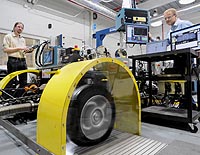Argonne research makes every day Earth Day
ARGONNE, Ill. (April 22, 2009) — Argonne National Laboratory is involved in a wide array of research and development projects aimed at advancing alternative energy sources and other “green” technologies in an effort to reduce greenhouse gases and ameliorate climate change, as well as to reduce reliance on fossil fuels and promote energy independence for the United States. Among those projects are:
- Solar Energy -- In an effort to help the world meet energy needs through solar power, Argonne along with Northwestern University created the Argonne-Northwestern Solar Energy Research Center. Scientists will examine new economical ways to use sunlight to produce clean fuels, such as hydrogen, from water and to produce electricity directly from low-cost photovoltaic and thermoelectric systems.
- Alternative Fuels – Scientists at Argonne are working to genetically manipulate algae to create the next generation of renewable fuels– hydrogen. Algae can be grown anywhere and may be able to produce hydrogen in the same amounts as oxygen.
- Environmental Clean-Up – Argonne's phytoremediation program uses fast-growing trees to remove pollution from groundwater.
- Energy-Efficient Supercomputer – Argonne's IBM Blue Gene/P supercomputer is not only one of the world's fastest computers for open science research, it is also one of the most energy-efficient.
- Pollution Control Programs – Argonne scientists are busy seeking ways to keep our air and water clean. A few examples:
- Studied and modeled air pollution in Beijing in an effort to improve air quality for spectators and athletes at the 2008 Summer Olympics.
- Used the Advanced Photon Source to create a new X-ray technique to view fuel expelled from fuel injectors. The research could lead to better and cleaner fuel injectors for automobiles.
- Created a cleaner way to produce ethylene, a common organic compound, without the harmful greenhouse gasses which result from current production methods.
- Developed a technology that removes radioactive material from nuclear power plant waste.
- In conjunction with Purdue University Calumet, identifying technologies to reduce pollution discharges into Lake Michigan by refineries and other large facilities.
- Climate Modeling – Argonne computational scientists have developed high-performance regional climate modeling simulations capability that allows climate researchers to study both past and future climate. Researchers at the laboratory are particularly interested in the study of the impact of extreme events on natural and human systems. The Argonne Leadership Computing Facility, one of the fastest public supercomputing facilities in the world, will improve our ability to understand and respond to climate change and global environmental issues through better observation, data, analysis, models and research.
- Recycling -- Argonne researchers have developed a technology to increase the recovery of plastics and other materials from obsolete cars and trucks. The materials can be re-used for new automotive parts and other applications instead of winding up in landfills.
Argonne National Laboratory seeks solutions to pressing national problems in science and technology.
The nation's first national laboratory, Argonne conducts leading-edge basic
and applied scientific research in virtually every scientific discipline. Argonne
researchers work closely with researchers from hundreds of companies, universities,
and federal, state and municipal agencies to help them solve their specific
problems, advance America 's scientific leadership and prepare the nation for
a better future. With employees from more than 60 nations, Argonne is managed
by UChicago
Argonne, LLC for
the U.S.
Department of Energy's Office
of Science.
For more information, please contact Steve McGregor (630/252-5580 or media@anl.gov) at Argonne.
Follow Argonne on Twitter at http://twitter.com/argonne.
|



